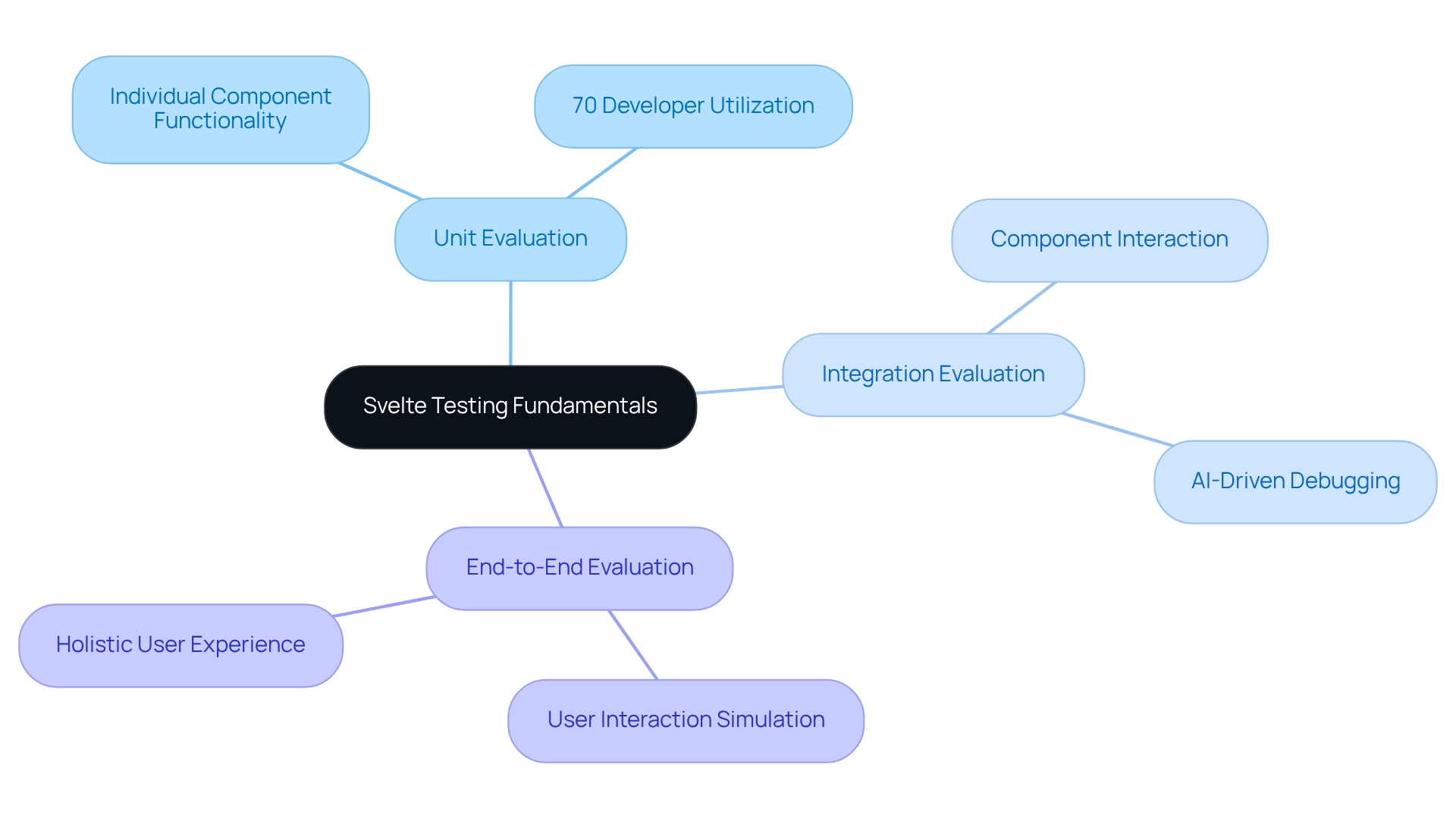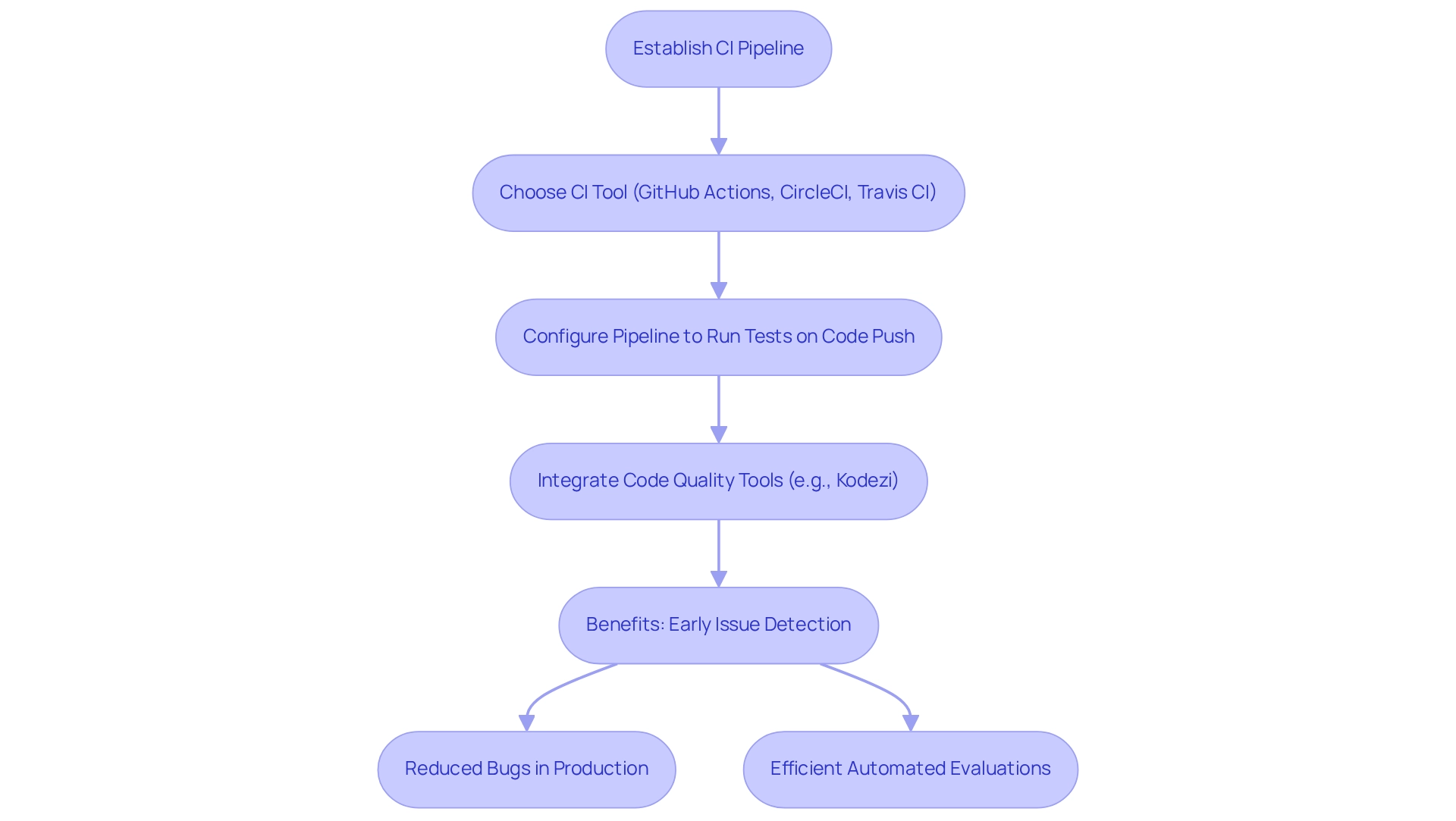Overview
The article begins by addressing the common coding challenges developers face, particularly in the realm of testing. It then introduces Kodezi as a solution that effectively tackles these issues through its innovative features. By detailing how Kodezi enhances productivity and code quality, the article illustrates the tangible benefits of its use. Ultimately, readers are encouraged to explore the tools available on the platform to improve their development processes.
The focus is on key strategies for efficient development in Svelte testing, emphasizing the importance of various testing methodologies such as unit, integration, and end-to-end evaluations. Furthermore, it explains how these strategies enhance code quality, reduce bugs, and streamline the development process. The integration of tools like Kodezi and continuous integration practices leads to more maintainable applications, showcasing the effectiveness of these approaches.
Have you considered how your current testing practices impact your workflow? By adopting Kodezi, developers can experience significant efficiency gains that not only improve their coding experience but also contribute to higher-quality applications. In addition, the article highlights the role of continuous integration in this process, making it clear that the right tools can transform development outcomes.
Introduction
In the rapidly evolving landscape of web development, the challenges of ensuring reliability and functionality in applications are ever-present. Developers often grapple with the complexities of maintaining high-quality code. Svelte, a modern JavaScript framework, emerges as a powerful ally in addressing these challenges. However, to fully leverage its capabilities, developers must adopt effective testing strategies.
This article delves into the essential methodologies of Svelte testing—unit, integration, and end-to-end testing—while exploring the tools and frameworks that streamline this process. By mastering these fundamentals and implementing a robust testing environment, developers can significantly enhance the quality of their applications, reduce bugs, and improve overall user experience.
With insights from industry experts and the integration of advanced tools like Kodezi, this guide equips developers with the knowledge needed to navigate the complexities of Svelte testing successfully.
Understand the Fundamentals of Svelte Testing
Slim framework evaluation is crucial for ensuring that components function as intended, encompassing three primary methodologies:
- Unit evaluation
- Integration evaluation
- End-to-end evaluation
Unit evaluations focus on individual components, confirming their functionality in isolation—an essential practice, as 70% of developers report utilizing unit evaluations in their applications. Integration tests assess how components interact with each other, while end-to-end tests simulate user interactions across the entire application, offering a holistic view of the user experience.
Understanding these assessment strategies is vital for selecting the most effective method for your projects. Svelte testing plays a pivotal role in this process, providing utility functions that streamline the rendering of components and the assertion of their behavior. This library simplifies evaluation practices, enabling developers to focus on crafting effective assessments through Svelte testing without being bogged down by setup complexities.
Expert insights highlight the importance of these assessment fundamentals. A leading Svelte evaluation specialist emphasizes that 'unit evaluation is the backbone of dependable applications, ensuring that each component operates as intended.' Moreover, organizations that implement robust evaluation frameworks experience a 55% reduction in rework due to earlier issue identification.
To enhance the evaluation process, AI-driven automated code debugging functionalities can be integrated into each assessment methodology. For unit evaluation, the platform can swiftly detect and resolve issues within individual elements, ensuring they perform as expected. In integration assessment, it aids in pinpointing interaction problems among components, while in end-to-end evaluation, the system guarantees that the entire application runs smoothly by addressing any underlying codebase issues.
By mastering these evaluation fundamentals and utilizing tools like Kodezi, developers can significantly improve the quality and maintainability of their applications. Are you ready to elevate your coding practices and explore the tools available on the platform?

Establish a Robust Testing Environment for Svelte
Creating a robust evaluation environment for your project begins with selecting a framework that aligns with your specific needs. Have you considered the popular options like Jest, Vitest, and Cypress? Installing the necessary dependencies via npm or yarn is your next step, followed by configuring your svelte testing framework to recognize components that resemble Svelte. For example, when using Jest, setting up a transformer for svelte testing files may be required.
In addition, integrating tools such as ESLint can enhance your code quality checks, while Prettier ensures consistent formatting. This setup not only facilitates smooth test execution but also guarantees adherence to best practices, ultimately fostering a more maintainable codebase. Research indicates that applications equipped with comprehensive logging can reduce troubleshooting time by up to 50%, underscoring the significance of a well-organized evaluation environment.
As Tien Nguyen Anh noted, "Playwright MCP Server enhances the AI capabilities for automation assessment," which highlights the critical nature of selecting the right evaluation frameworks. Furthermore, to implement a snapshot assessment, consider utilizing the toMatchSnapshot() method in Jest. By following these guidelines, you can establish an evaluation environment that supports the long-term health and scalability of your applications.
Implement Effective Testing Strategies for Svelte Applications
Developers often face significant challenges in coding, particularly when it comes to ensuring the robustness of their applications. To guarantee strong Svelte applications, it is essential to apply effective evaluation strategies, including:
- Svelte testing
- Unit evaluations
- Integration evaluations
- End-to-end evaluations
Starting with thorough unit evaluations for individual components—focusing on props, events, and state changes—is crucial. Statistics reveal that addressing bugs in poorly tested modules can consume 30-40% of project time, making this foundational step vital.
Furthermore, employing integration evaluations confirms the interactions between components, ensuring accurate communication and expected data flow. End-to-end evaluations are equally important, as they mimic user behavior and encompass vital user journeys, verifying that the application operates as intended from the user's perspective. Incorporating Svelte testing can enhance your evaluation process by simplifying assertions and improving test readability.
In addition, real-world examples show that teams utilizing these strategies not only reduce bugs but also enhance the overall reliability of their applications. By prioritizing these evaluation methodologies, developers can create a more maintainable codebase and streamline their development workflow. The integration of Kodezi into your development process can significantly improve these evaluation techniques. The AI-driven automated builds and testing features assist in identifying bugs early, ensuring improved code quality with every release.
Moreover, the CLI features enable teams to auto-heal codebases, further streamlining the development process. As emphasized by over 1,000,000 content users, Kodezi has revolutionized debugging and programming efficiency, allowing developers to focus on more advanced tasks. User testimonials highlight how the platform's features, such as the automated assessment tools and the CLI, enhance overall efficiency.
Similarly, the vibrant community support behind tools like Vitest demonstrates that continuous improvement and adaptability are crucial in software development. By prioritizing these evaluation methodologies and leveraging Kodezi's advanced features, developers can create a more maintainable codebase and streamline their development workflow. This ultimately leads to a more efficient and productive development experience.
Leverage Continuous Integration and Automated Testing
To effectively implement continuous integration and automated Svelte testing in your Svelte projects, consider the common coding challenges developers face. Establish a CI pipeline utilizing platforms such as GitHub Actions, CircleCI, or Travis CI. This pipeline should be configured to automatically execute your tests whenever code is pushed to the repository, ensuring that new changes are validated against your test suite. This proactive approach helps catch issues early in the development process, significantly reducing the likelihood of bugs in production.
Furthermore, integrating code quality tools into your CI workflow is essential. Tools like Kodezi can automatically analyze and fix bugs, providing detailed explanations of issues and ensuring that your code adheres to the latest security best practices and coding standards. Organizations that have implemented comprehensive CI pipelines report a 55% decrease in rework due to earlier issue identification, highlighting the efficiency of automated evaluations.
In addition, a significant percentage of teams are leveraging GitHub Actions, CircleCI, or Travis CI for automated evaluations, reflecting a growing trend in the Svelte community. By automating Svelte testing and embedding it within your CI processes, you can maintain high code quality and ensure a smoother development lifecycle. Regular updates to configurations are necessary to align with evolving project requirements, making the delivery of software a reliable, predictable, visible, and largely automated process with well-understood, quantifiable risks.

Conclusion
Svelte testing is essential for web development, addressing the challenges developers face in ensuring applications are reliable, functional, and user-friendly. By understanding and implementing the three core testing methodologies—unit, integration, and end-to-end testing—developers can safeguard the quality of their applications effectively. The Svelte Testing Library simplifies this process, allowing developers to focus on what truly matters: delivering high-quality software.
Establishing a robust testing environment is equally crucial. By selecting the right testing frameworks and integrating tools like ESLint and Prettier, developers can create a streamlined workflow that promotes maintainability and adherence to best practices. This structured approach enhances the efficiency of the testing process and significantly reduces troubleshooting time, leading to a more resilient codebase.
Furthermore, incorporating continuous integration and automated testing into the development lifecycle amplifies these benefits. By automating tests and integrating code quality tools, teams can catch issues early, minimizing the risk of bugs in production and fostering a culture of quality assurance. The integration of advanced tools like Kodezi enhances these methodologies, providing AI-driven support that streamlines debugging and improves overall productivity.
In conclusion, mastering Svelte testing and establishing a comprehensive testing environment are vital steps for developers aiming to create high-quality applications. By prioritizing effective testing strategies and leveraging the right tools, developers can significantly improve the reliability and user experience of their Svelte projects, paving the way for successful and sustainable web development.
Frequently Asked Questions
What are the primary methodologies for Svelte testing?
The three primary methodologies for Svelte testing are unit evaluation, integration evaluation, and end-to-end evaluation.
What is the focus of unit evaluations in Svelte testing?
Unit evaluations focus on individual components, confirming their functionality in isolation.
How do integration tests differ from unit evaluations?
Integration tests assess how components interact with each other, while unit evaluations focus on individual components.
What do end-to-end tests simulate?
End-to-end tests simulate user interactions across the entire application, providing a holistic view of the user experience.
Why is understanding these assessment strategies important?
Understanding these assessment strategies is vital for selecting the most effective method for your projects.
How does Svelte testing assist developers?
Svelte testing provides utility functions that streamline the rendering of components and the assertion of their behavior, simplifying evaluation practices.
What is the significance of unit evaluation according to experts?
Experts emphasize that unit evaluation is the backbone of dependable applications, ensuring that each component operates as intended.
What benefit do organizations experience by implementing robust evaluation frameworks?
Organizations that implement robust evaluation frameworks experience a 55% reduction in rework due to earlier issue identification.
How can AI-driven automated code debugging enhance the evaluation process?
AI-driven automated code debugging can swiftly detect and resolve issues within individual elements for unit evaluation, pinpoint interaction problems for integration assessment, and ensure the entire application runs smoothly in end-to-end evaluation.
What tools can developers use to improve the quality and maintainability of their applications?
Developers can utilize tools like Kodezi to significantly improve the quality and maintainability of their applications.




